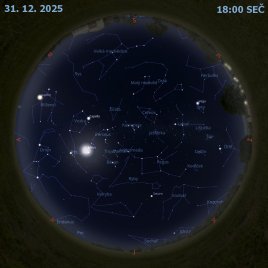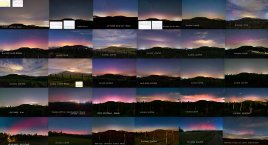Rovnodennost na otáčející se Zemi
Uznání: Meteosat 9, NASA, earthobservatory, Robert Simmon
Kdy se hranice mezi dnem a nocí stává vertikální? Dnes. Dnes je na planetě Zemi rovnodennost, tedy období roku, kdy jsou den a noc téměř stejně dlouhé. Při rovnodennosti se zemský terminátor, dělící čára mezi dnem a nocí, stává svislým a spojuje severní a jižní pól. Časosběrné video to demonstruje zobrazením celého roku na planetě Zemi během dvanácti sekund. Družice Meteosat 9 pořizuje z geosynchronní dráhy infračervené snímky Země každý den ve stejnou dobu místního času. Video začíná při rovnodennosti v září 2010, kdy je linie terminátoru svislá. Jak Země obíhá kolem Slunce, tak je vidět, že se terminátor naklání tak, že na severní polokouli dopadá denně méně slunečního světla, což způsobuje zimu na severu. Jak rok pokračuje, tak v polovině videa v březnu 2011 nastává opět rovnodennost a poté se terminátor naklání na opačnou stranu, což způsobuje zimu na jižní polokouli a léto na severní. Zaznamenaný rok opět končí zářijovou rovnodenností, čímž končí další z miliard cest, které Země podnikla, a ještě kolem Slunce podnikne.
Seznam odkazů v popisu
- Wikipedia: Equinox
- Wikipedia: Terminator_(solar)
- NASA: Which pole is colder?
- APOD: 2013-12-11 Nejchladnější místo na Zemi
- Youtube.com: Equinox on a Spinning Earth
- Wikipedia: Meteosat
- NASA: Geosynchronous Satellites
- NASA: Seeing Equinoxes and Solstices from Space
- Time.gov: NIST: THE OFFICIAL U.S. TIME
- APOD: September 2010
- NASA: Earth
- NASA: What Causes the Seasons?
- APOD: March 2011
- Giphy.com: Foto: Pejsek naklání hlavu :-)
- UniverseToday.com: Why Are There Seasons?
- APOD: 2019-09-23 Rovnodennost: Slunce od slunovratu ke slunovratu
NASA Official: Phillip Newman Specific rights apply. NASA Web Privacy Policy and Important Notices
A service of: ASD at NASA / GSFC & Michigan Tech. U.
Odkaz na originální APOD


